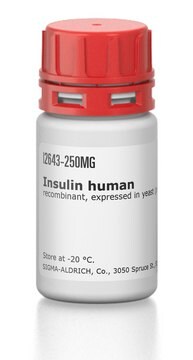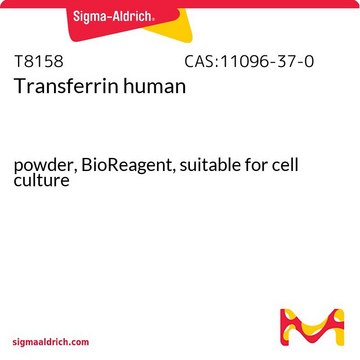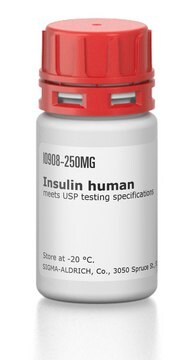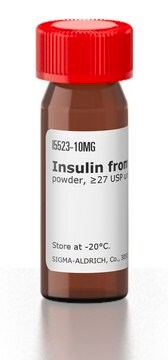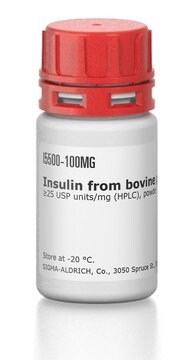I3536
Insulin human
recombinant, expressed in yeast, γ-irradiated, suitable for cell culture
Synonim(y):
Insulin human
About This Item
Polecane produkty
rekombinowane
expressed in yeast
Poziom jakości
sterylność
γ-irradiated
Postać
lyophilized powder
siła działania
≥25 USP units per mg
metody
cell culture | mammalian: suitable
rozpuszczalność
0.01 M HCl: 20 mg/mL, clear, colorless to faintly yellow
numer dostępu UniProt
Warunki transportu
ambient
temp. przechowywania
−20°C
Klucz InChI
PBGKTOXHQIOBKM-FHFVDXKLSA-N
informacje o genach
human ... INS(3630)
Szukasz podobnych produktów? Odwiedź Przewodnik dotyczący porównywania produktów
Opis ogólny
Zastosowanie
- For adipogenic differentiation assays (in the preparation of medium supplement)
- Incubation of cells for the evaluation of the effects of insulin
- Mass spectrometry (used for the external caliberation)
Działania biochem./fizjol.
Inne uwagi
Kod klasy składowania
13 - Non Combustible Solids
Klasa zagrożenia wodnego (WGK)
WGK 2
Temperatura zapłonu (°C)
Not applicable
Certyfikaty analizy (CoA)
Poszukaj Certyfikaty analizy (CoA), wpisując numer partii/serii produktów. Numery serii i partii można znaleźć na etykiecie produktu po słowach „seria” lub „partia”.
Masz już ten produkt?
Dokumenty związane z niedawno zakupionymi produktami zostały zamieszczone w Bibliotece dokumentów.
Klienci oglądali również te produkty
Nasz zespół naukowców ma doświadczenie we wszystkich obszarach badań, w tym w naukach przyrodniczych, materiałoznawstwie, syntezie chemicznej, chromatografii, analityce i wielu innych dziedzinach.
Skontaktuj się z zespołem ds. pomocy technicznej
